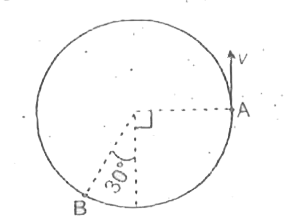A particle moves with constant speed v along a circular path of radius r and completes the circle in time T. The acceleration of the particle is
2πvT
2πrT
2πr2T
2πv2T
The correct Answer is:A
To solve the problem, we need to find the acceleration of a particle moving with constant speed v along a circular path of radius r and completing the circle in time T.
Step 1: Understand the type of acceleration in circular motion.
- In circular motion, when a particle moves along a circular path at a constant speed, it experiences centripetal acceleration directed towards the center of the circle.
Step 2: Write the formula for centripetal acceleration.
- The formula for centripetal acceleration a is given by:
a=v2r
where v is the constant speed of the particle, and r is the radius of the circular path.
Step 3: Relate speed to the time period.
- The speed v can also be expressed in terms of the time period T and the radius r. The relationship is:
v=2πrT
This equation comes from the fact that the distance traveled in one complete revolution (the circumference of the circle) is 2πr, and it takes time T to complete this distance.
Step 4: Substitute the expression for speed into the acceleration formula.
- Now, substituting v=2πrT into the centripetal acceleration formula:
a=(2πrT)2r
Step 5: Simplify the expression.
- Simplifying the equation:
a=4π2r2T2⋅1r=4π2rT2
Step 6: Final result.
- Therefore, the acceleration of the particle is:
a=4π2rT2
Conclusion:
The acceleration of the particle moving in a circular path with constant speed v is 4π2rT2.
- In circular motion, when a particle moves along a circular path at a constant speed, it experiences centripetal acceleration directed towards the center of the circle.
- The formula for centripetal acceleration a is given by:
a=v2r
where v is the constant speed of the particle, and r is the radius of the circular path.
- The speed v can also be expressed in terms of the time period T and the radius r. The relationship is:
v=2πrT
This equation comes from the fact that the distance traveled in one complete revolution (the circumference of the circle) is 2πr, and it takes time T to complete this distance.
- Now, substituting v=2πrT into the centripetal acceleration formula:
a=(2πrT)2r
- Simplifying the equation:
a=4π2r2T2⋅1r=4π2rT2
- Therefore, the acceleration of the particle is:
a=4π2rT2
The acceleration of the particle moving in a circular path with constant speed v is 4π2rT2.
Topper's Solved these Questions
- CIRCULAR MOTIONBOOK - DC PANDEY ENGLISHCHAPTER - CIRCULAR MOTIONEXERCISE - Taking it together
67 Videos
- CIRCULAR MOTIONBOOK - DC PANDEY ENGLISHCHAPTER - CIRCULAR MOTIONEXERCISE - Match the columns
3 Videos
- CIRCULAR MOTIONBOOK - DC PANDEY ENGLISHCHAPTER - CIRCULAR MOTIONEXERCISE - Integer
7 Videos
- CENTRE OF MASS, LINEAR MOMENTUM AND COLLISIONBOOK - DC PANDEY ENGLISHCHAPTER - CENTRE OF MASS, LINEAR MOMENTUM AND COLLISIONEXERCISE - Level 2 Subjective
21 Videos
- COMMUNICATION SYSTEMBOOK - DC PANDEY ENGLISHCHAPTER - COMMUNICATION SYSTEMEXERCISE - Only One Option is Correct
27 Videos
Similar Questions
A particle of mass M moves with constant speed along a circular path of radius r under the action of a force F. Its speed is
View SolutionA particle of mass m moves with constant speed v on a circular path of radius r. Find magnitude of average force on it in half revolution.
View SolutionA particle of mass m moves with constant speed v on a circular path of radius r as shown in figure. The average force on it during its motion from A to B is

View SolutionA particle with the constant speed in a circle of radius r and time period T.The centripetal acceleration of a particle is
View SolutionA particle is moving along a circular path of radius 5 m with a uniform speed 5ms−1. What will be the average acceleration when the particle completes half revolution?
View SolutionA particle is moving with a constant speed along a straight line path. A force is not required to
View SolutionA particle moves in a circle of radius 5 cm with constant speed and time period 0.2πs. The acceleration of the particle is
View SolutionA particle of mass m is tied to light string and rotated with a speed v along a circular path of radius r. If T=tension in the string and mg= gravitational force on the particle then actual forces acting on the particle are
View SolutionA particle is revoiving in a circular path of radius 25 m with constant angular speed 12 rev/min. then the angular acceleration of particle is
View SolutionA particle is moving in a circular path of radius r. The displacement after half a circle would be
View Solution
